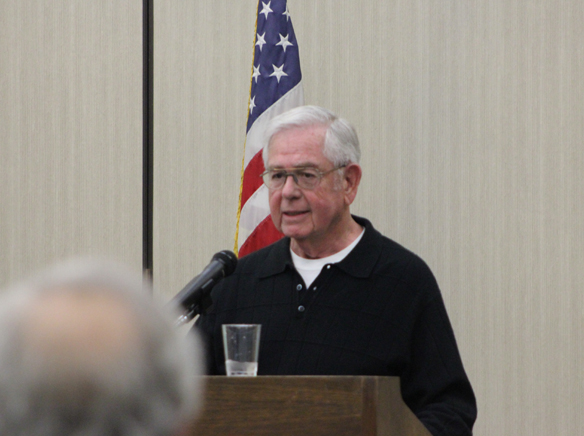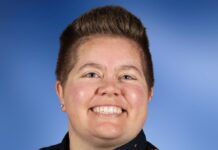Del Hood, the retired former executive editor of The Daily Californian of El Cajon, which went out of business after more than a century of existence in 1999, spoke on the history of newspapers in the city on Jan. 17 at the Ronald Reagan Community Center in El Cajon.
Del Hood, the retired former executive editor of The Daily Californian of El Cajon, which went out of business after more than a century of existence in 1999, spoke on the history of newspapers in the city on Jan. 17 at the Ronald Reagan Community Center in El Cajon.
Titled “Newspapers in El Cajon Valley: Conservative Reed, Crusader Casady and the Four Chains,” Hood’s speech was a humorous, colorful and insightful account of the editors of El Cajon’s newspapers throughout time.
Noting the first newspaper opened in El Cajon 124 years ago, Hood talked about what else was happening in the world then, illustrating just how much times have changed.
“Annie Oakley was touring Europe with the Buffalo Bill Wild West Show demonstrating her marksmanship by shooting a cigar out of Kaiser Wilhelm’s mouth,” he said. “Asa Briggs Candler of Atlanta bought the rights to a local drink called Coca-Cola.”
“And in El Cajon, the El Cajon Star published its first issue on May 18, 1889,” Hood said noting the “Spanish-American War wouldn’t start for another nine years.”
Francis Whaley, El Cajon’s first editor “was given to the use of superlatives.”
“He chose to use the slogan, ‘The only paper on Earth,’ ” said Hood adding, “Readers must have wondered what other fibs he was telling. That might be a reason why the paper didn’t survive very long.”
W.D. Hall and H.H. Kessler, who, Hood said, also operated the town’s lumberyard, and owned El Cajon’s second paper, a weekly.
“Kessler apparently was an aspiring newspaperman because he had a foot-powered press and a couple of cases of type – this was about all you needed in those days to start a newspaper,” Hood said.
Moving on to the city’s next newspaper editor, William H. Somers, Hood noted, “Like me, he was a transplanted Nebraskan.”
Somers arrived in El Cajon in 1886, and planted some of the first orange trees in the valley, as well as engaging in real estate, said Hood, adding the newspaper then cost $1 a year. But he added there was a liberal credit policy.
“Subscriptions were payable in butter, eggs, wood, vegetables, fruit, spring chickens and setting hens, or any other product of land or sea that we can eat, wear or barter,” said Hood, adding provisions were made for “delayed” payments by subscribers, who were asking to notify Somers when they expected “the hens to lay, the fruit to ripen or the cash to come in.”
Though Somers retired from the newspaper business in 1898, his claim to fame, said Hood was that he was the first editor to establish a newspaper in El Cajon that lasted, mostly endearing himself to locals by making the paper as folksy, charming and down to earth as he could. Hood said Somers’ paper used “lots of names with brief items written in simple sentences.”
In 1938, Henry C. Reed and his son Carlyle, who had a weekly newspaper in Imperial Valley and a commercial printing shop in Arizona, bought the El Cajon paper. Hood said the pair put together a string of weeklies in East County named the La Mesa Scout, the Lemon Grove Review, the El Cajon Valley News, the Lakeside Reader and the Mountain Empire Chronicle. Hood noted the circulation of The Valley News at that time was about 550 out of a total population of less than 1,500.
In an article for The Daily Californian’s 100th anniversary edition in 1992, it was noted that Carlyle Reed’s publications “pinpointed where every business was located,” as well as crusaded against things like “bridge-bingo games” in downtown restaurants.
“Carlyle did quite well for himself,” said Hood, noting he opened a public relations business, lobbied in Sacramento on water issues, became publisher of the Sacramento Union (a Copley property), and ended his career as associate publisher of the Washington Times.
Iowa-born Simon Casady, whose father was an Episcopalian priest, was El Cajon’s next newspaper editor.
Hood described Casady as tempestuous, noting he “brought his editorial cannons to El Cajon and proceeded to fire them at public figures he determined were supporting wrong-headed policies.”
In his speech, Hood noted Casady “didn’t let anything get in the way of expressing his opinions,” going so far as to order press times delayed, to the consternation of everyone including advertisers,“ until he could finish his editorials.”
“Casady may have been undone, not by what he wrote so much as by his determination to expand his influence by taking the newspaper daily in 1961,” said Hood.
Hood concluded his speech by discussing the Baker years of 1964-1977, and the paper’s ultimate sale to Landmark Communications based in Norfolk, Va. In 1977, a national newspaper chain brought it into modern times, moving its operations into a spacious new building at 1000 Pioneer Way, buying a new press, hiring more staff and providing color-coordinated workplaces and new computers.
“Landmark brought in a constantly changing roster of publishers to improve the financial outlook and hopefully, make a profit,” said Hood, lamenting none of them succeeded.
Hood, who is about to turn 80, retired from The Daily Californian in 1995 but continued to work part-time for the paper until the end of 1999, when the paper was sold to San Diego Neighborhood Newspapers Co., which brought the paper full circle by converting it back to a weekly publication, The East County Californian.
“As you know, El Cajon now has two weeklies – one more than it had in 1889,” concluded Hood.
Following his speech, when asked about the future of the print media, Hood said, “not good,” noting the medium, especially dailies nationwide, are struggling to cope with the information age and the electronic revolution and the Internet, which are rapidly transforming the newspaper industry, changing the way news is packaged and disseminated.
Asked whether he thinks newspapers will survive in the future, Hood replied, “I hope so.”














